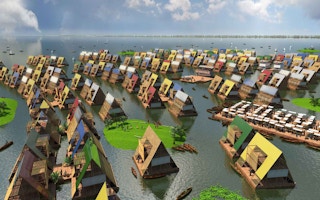“Water is one of our most pressing global risks,” says Henk Ovink, special envoy for international water affairs for the Netherlands. When floods or tsunamis strike coastal regions, the devastation can be immense, particularly in densely built, poorly constructed neighbourhoods in cities across the global South.
But crises like flooding shouldn’t mean death, destruction and displacement. By constructing buildings and infrastructure that work with nature not against it, cities and countries will be far more resilient, Ovink says.
Architects such as Yasmeen Lari in Pakistan, Shigeru Ban in Nepal and Alejandro Aravena in Chile have been working with local people to pioneer new ways of designing safe and disaster-resilient buildings.
The idea of architects as “big heroes who will bring salvation to the world” is fast being replaced by architecture that involves and is shaped by the people who use it, Ovink says.
This interview was recorded this week at Creation from catastrophe: How architecture rebuilds communities, an exhibition at the Royal Institute of British Architects in London, United Kingdom.
This article was originally published on SciDev.Net. Read the original article.










